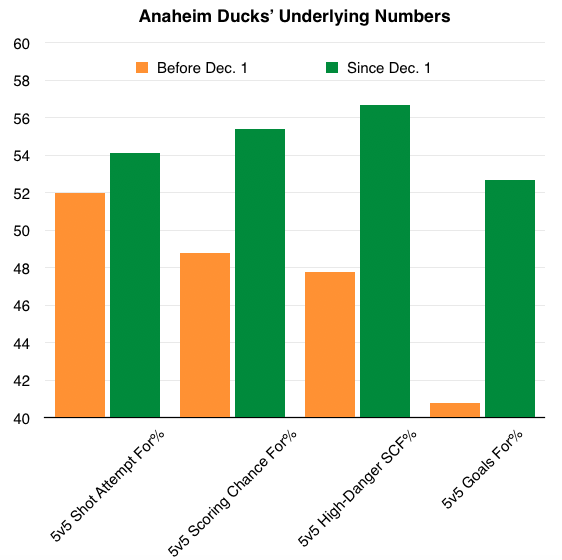Heading into the 2015-16 season few teams – if any – had higher expectations surrounding them than the Anaheim Ducks.
Early on it looked like they wouldn’t come close to reaching said expectations as they stumbled out of the gate winning just nine of their first 25 games.
Heading into December they were just five points out of last place in the NHL and teams like the Buffalo Sabres, Ottawa Senators and Winnipeg Jets, among others, were higher than they were in the standings.
The Ducks probably played better than their record at that point would suggest, however, they certainly were not playing as well as everyone expected.
Fast forward a few months and the Ducks are the hottest team in hockey and now sit just two points out of 1st place in the Pacific Division.
That’s no fluke, either. The Ducks have been a dominant team at 5 v 5 and they’re reaping the rewards for it.
The shot attempt numbers haven’t changed drastically from when they were struggling, but they’re getting a much larger share of the scoring chances which, as you would expect, has led to a larger share of the goals.
It took a while but Bruce Boudreau’s Ducks are now a well oiled machine and are looking the part of the serious Stanley Cup contender they were expected to be.
—
One name that seems to be garnering a lot of interest leading up to the trade deadline is Arizona Coyotes forward Mikkel Boedker.
On the surface it makes some sense – he’s an excellent skater, has some offensive ability and is just 26-years-old (making him attractive to teams hoping for a long-term fix). As such the asking price from Arizona is expected to be very high.
When you look deeper into what Boedker is and what he brings to the table, he’s far less attractive.
Since the beginning of the 2013-14 season he averages just 1.34 points per 60 minutes of 5 v 5, good for 234th among 350 eligible forwards (minimum 1,200 5 v 5 minutes).
That ranks Boedker below the likes of Darren Helm, Matt Stajan, John Mitchell, Brad Richardson, Dwight King and Vern Fiddler, among many others.
Boedker isn’t exactly good in possession, either, and has a long history of injuries.
He is a guy whose perceived value far outweighs his actual on-ice value. It’s usually not good business to acquire guys like that.
—
One of the most interesting things about each trade deadline, and the days leading up to it, is seeing what the market price settles at for rental players.
Depending on the amount of buyers, sellers and quality of available players – or lack thereof – the prices tend to vary from year-to-year.
If a pair of recent trades from the Toronto Maple Leafs are any indication, it appears this year it’s a sellers market.
The Leafs managed to get a 4th round pick and a good, young AHL player (Colin Smith) for a player with six goals carrying a $2,300,000 cap hit.
The Leafs followed that up by landing a pair of 2nd round picks for a 3rd pairing defenseman in Roman Polak and bottom-6 forward in Nick Spaling. They did take on Raffi Torres’ unwanted contract, but it expires at years end, anyway, so you’d find very few people who don’t think Lou Lamoriello and co. did exceptionally well here.
With a lot of teams still in the hunt looking for an extra piece or two to bolster their chances of making the playoffs – and perhaps doing something once they’re there – this certainly seems like a year to sell.
That’s why I think over-achieving bubble teams like the New Jersey Devils would be smart to sell off their pending UFAs (notably Lee Stempniak and David Schlemko) in a favorable trade market and reap the benefits long-term.
It’ll be interesting to see if they feel the same way.
Written by Todd Cordell, who can be found on twitter @ToddCordell.
